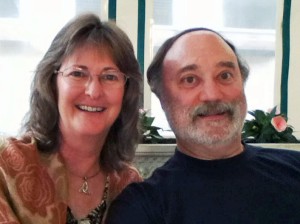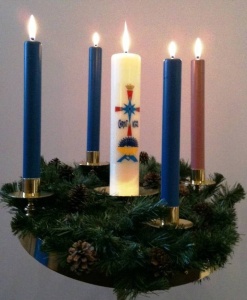Dear Brothers and Sisters in Christ,  Sometimes we are so excited about celebrating the Incarnation of the Son of God at Christmas that we neglect Advent, the season that begins the annual Christian worship calendar. Spanning the four Sundays preceding Christmas, Advent this year begins November 30. The word “advent” is from adventus (Latin), meaning “coming” or “arrival.” Advent celebrates Jesus’ three “comings” (typically in reverse order): future (Jesus’ return), present (in the Spirit) and past (Jesus’ incarnation/birth).
Sometimes we are so excited about celebrating the Incarnation of the Son of God at Christmas that we neglect Advent, the season that begins the annual Christian worship calendar. Spanning the four Sundays preceding Christmas, Advent this year begins November 30. The word “advent” is from adventus (Latin), meaning “coming” or “arrival.” Advent celebrates Jesus’ three “comings” (typically in reverse order): future (Jesus’ return), present (in the Spirit) and past (Jesus’ incarnation/birth).

Our understanding of Advent is enriched when we note how these three comings interrelate. The author of Hebrews used this phrase: “Jesus Christ is the same yesterday and today and forever” (Hebrews 13:8). Jesus came in the Incarnation (yesterday), he lives in us now through the Spirit (today) and will return as King of kings and Lord of lords (forever). Another way to look at this is in terms of the kingdom of God. Jesus’ incarnation brought the kingdom to humanity (yesterday), he invites believers to enter in and participate in that kingdom (today) and when he returns, he will reveal the already-existing kingdom to all humanity (forever).
Jesus used several parables to explain the kingdom that he was establishing: the parable of the seed, which grows invisibly and quietly (Mark 4:26-29); the parable of the mustard seed, which grows from a small seed to a large bush (Mark 4:30-32); and the parable of the yeast, which leavened all the flour (Matthew 13:33). These parables show that the kingdom was brought to earth at the Incarnation and still exists as a reality today. Jesus also said, “If I cast out demons by the Spirit of God [which he did], then the kingdom of heaven has come to you” (Matthew 12:28; Luke 11:20). The kingdom is here, he said, and the proof is in the exorcisms and other good works of the church.
The power of God is continually manifest through believers who live in the reality of the kingdom. Jesus Christ is the head of the church yesterday, today and forever. Just as the kingdom was present in the ministry of Jesus, it is present now (though not yet fully) in the ministry of his church. The King is among us; his spiritual power is in us, even though his kingdom is not yet operating in full power. Martin Luther analogized that Jesus has bound Satan but with a long chain: “He [Satan] can do no more than a bad dog on a chain, which may bark, run here and there, and tear at the chain.”
The fullness of the kingdom will come—that is the “forever” we hope for. We know no matter how much we try to live in a way that reflects God, we cannot transform the entire world into God’s kingdom today. Only Jesus can do that, and he will at his glorious return. So while the kingdom has a present reality, its fullness is in the future. Though largely hidden today, the kingdom will be completely manifested at Jesus’ final advent.
Paul spoke often of the kingdom in its future sense. He warned against the things that prevent people from “inheriting the kingdom of God” (1 Corinthians 6:9-10; 15:50; Galatians 5:21; Ephesians 5:5). As his language often reflected, Paul predominantly thought of the kingdom as realized at the end of the age (1 Thessalonians 2:12; 2 Thessalonians 1:5; Colossians 4:11; 2 Timothy 4:1, 18). However, he also understood that wherever Jesus is, his kingdom is now present, even in what he called “this present evil age” (Galatians 1:4). Since Jesus lives in us now, the kingdom is now present and, as Paul taught, we are now citizens of the kingdom of heaven (Philippians 3:20).
Advent is also spoken of in terms of our salvation, which the New Testament refers to in three tenses: past, present and future. The past tense is our finished salvation. It is what Jesus accomplished in his first coming—through his life, death, resurrection and ascension. The present tense is what we have now—Jesus living in us and inviting us to participate in his kingdom work. The future tense is the fullness of salvation, which we will experience when Jesus visibly returns and God is all in all.
It’s interesting to note that the Bible emphasizes the visibility of Jesus’ first coming and final coming. In between the “yesterday” and “forever,” Jesus’ present coming is invisible in that we do not see him walking around as they did in the first century. However, because we are now ambassadors for Christ (2 Corinthians 5:20), we are called to represent the reality of Christ and his kingdom. So while Jesus may not be visible, we know he is with us and will never leave or forsake us, and others can see Jesus through us. We are called to make visible some of the glories of the kingdom—doing so by allowing the fruit of the Spirit to flow through us and by keeping Jesus’ new commandment to love one another (John 13:34-35).
When we understand that Advent focuses on Jesus yesterday, today and forever, we are better able to understand the four traditional Advent themes (represented in the wreath pictured above): hope, peace, joy and love. As the Messiah the prophets spoke of, Jesus is the reality of the hope that sustained God’s people. He did not come as a warrior or conquering king but as the Prince of peace, showing that God’s plan was to bring peace. The theme of joy focuses on the joyous anticipation of the birth and return of our Savior. And love is what God is all about. God, who is love, loved us yesterday (before the foundation of the world) and continues to love us (individually and intimately) both today and forever.
I pray your Advent season is filled with Jesus’ hope, peace and joy along with daily reminders through the Spirit of just how much he loves you.
Trusting Jesus yesterday, today and forever, Joseph Tkach
PS: For more on the present and future reality of the kingdom of God, see the article “The Present and Future Kingdom of God” at www.gci.org/gospel/kingdom and the series of articles in GCI Weekly Update on the kingdom of God by Gary Deddo that begins at update.gci.org/2014/02/the-kingdom-of-god-part-1/.



Dag Hammarskjöld, former secretary-general of the United Nations, wrote in “Markings”, a manuscript that was published after his death:
“How proper it is that Christmas should follow Advent. For him who looks towards the future, the manger is situated on Golgotha, and the cross has already been raised in Bethlehem.”
Source: 1000 Illustrations for Preaching & Teaching